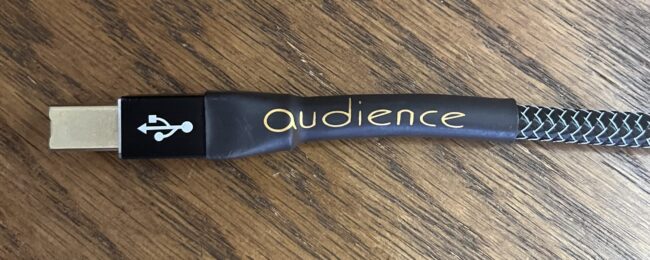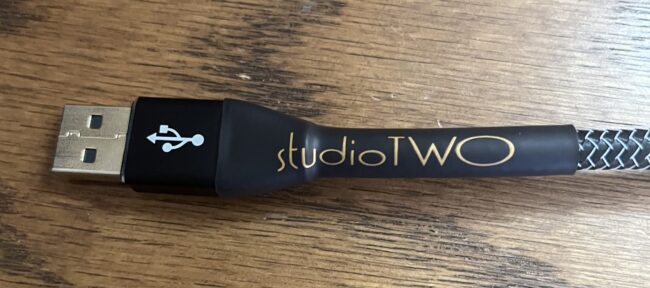Bits is bits, right? Maybe the computer bits really are just little blocks of information, static and unchanged and unchangeable from the recording studio to your awesome music system. However, the reality is that the way those bits travel from one point in the recording process to the final point in the listening chain can change the sound you hear. A lot.
Notice: If you can’t wrap your head around the proposition that digital sound can be altered by cables, STOP reading now.

Which brings us to the new Audience Studio TWO USB cable, $499 for a 1 meter A-B cable. To tell you that this was an ear opener would be an understatement. From the Audience Web site (link below):
“Like all Audience cables, Studio TWO is a low-mass design. We avoid using heavy jacketing materials and heavy connectors on our cables as mass tends to absorb energy and dulls the sound. This lack of extra weight gives Studio TWO their refreshingly open and honest tonal character.”
Digital components on hand during the audition and review include a custom Windows 10 computer running JRiver Media Center with USB-connected Bricasti M1 Series II and Audio-gd R7 Mk2 DACs, and RME ADI-2 Pro fs r Black Edition AD/DAC with external power supply. The system also includes an Acoustic Signature Montana Neo turntable with Acoustic Signature TA-7000 Neo and Origin Live Agile tonearms; a ZYX UNIverse Optimum, Miyajima Destiny, Koetsu RSP, and Tzar DST moving coil phono cartridges; CH Precision P1-X1 phono preamplifier; Soulution 325 with phono and Benchmark HPA4 preamplifiers; Valvet E2 SE and Benchmark AHB2 power amplifiers; Alta Audio Celesta FRM-2M, B&W 805 D4 and Magico S1 MkII speakers.
The 2-way speakers are lightly augmented in the low bass, as needed, with one or two JL Audio e110 subwoofers*. The audio cabling is Audioquest WEL Signature and Mogami interconnects and speaker cables. USB cables are Audience Front Row and Straight Wire USB-F. Power cords include my DIY power cord and Straight Wire Pro Thunder. Power protection and purification are provided by a PS Audio Dectet for the preamplifiers and source components, and a PS Audio Quintet for the power amplifiers. The Quintet includes a standard 1/8″ trigger connection enabling remote turn-on and -off of power amplifiers that lack a 12V remote trigger, which is a feature that every modern component should include.
*I have previously recommended using two subwoofers to help “even out” the bass response in the listening room, minimizing peaks and nulls. This is still good advice if more than one person is listening. But for daily solo music listening, using only one subwoofer tuned specifically for the listening position can be an improvement. One subwoofer can make the bass sound a bit tighter by eliminating the sound from the second subwoofer. Two subs can muddy the bass unless both subs are tuned exactly the same for the sweet spot.

Most of the software (music files) are 32-bit 384kHz WAV files created from LP. Regardless of the fact that 32-bits is most likely overkill for humans listening to, well, anything, a 32-bit file simply sounds better than a 24-bit recording of the same cut of music. A wide selection of CD rips were also used for this evaluation. CDs are ripped to WAV at their native 16-bit 44.1kHz resolution, and upsampled 4x to 176.4kHz in JRiver. CD rips require about 300 MB of storage space for each album “side”. Compare that to the disk space required for 32-bit 384kHz recordings: around 4 GB per record side. Some 24-bit 96kHz downloads were also heard. I advocate whole number upsampling, so these downloads are also upsampled 4x to 384kHz. The 32-bit 384 kHz recordings are not upsampled in JRiver.
The overall presentation is detailed, extended in the low bass and high treble, and very 3-dimensional. The lower frequencies are richly saturated and powerful. The resolution in the bass, especially during crescendos or long, louder passages can be a test of the bass performance of your speakers and how they interact with your listening room. Loud music, often reaching the upper limit of the loudness of digital – all 1s and no 0s – is also a test of the sound engineer’s ability to make a clean recording without overs. Overs are also called “clipping”, which are often addressed in production with compression. None of my LP recordings use compression because with 32-bit depth there is no need to push the loudness red line.
The Studio TWO cable continues the excellent performance into the midrange, giving vocals – both male and female – the required weight, warmth, and presence. This important frequency range will put a smile on your face, especially if the Studio TWO is an upgrade from a lesser USB cable (which does not exclude more expensive cables).
Mark Knopfler’s vocals on the Dire Straits white album are perfectly identifiable and correct. His vocal inflections and nuance are well presented and give added meaning to his story telling. Likewise, the recording of Joan Armatrading’s Hearts and Flowers is very true to the reference LP. Her distinct sound is a treat to hear, which I have enjoyed on recordings and several live performances over the years. The digital files of this album capture the “analog magic” of the LP very well.
Moving up in frequency, the upper midrange and lower treble is the Achille’s Heel of many components, active and passive. This definitely includes cables. Most of the whatever harshness or non-musical anomalies that you hear have a strong presence in this frequency range. This would include most instances of 1st harmonics from the midrange. Studio TWO won’t cover up or hide problems in this area. The cable has the transparency and truthfulness to be accurate to the source but does not exacerbate sonic problems. It is not a bright, harsh or forward sounding cable.
For a good example of an excellent commercial recording, check out “Give Me That” on Basia’s album Brave New Hope. The Studio TWO keeps this studio recording clear and unambiguous, while delivering her voice in exquisite detail and warmth. There are many other good cuts on this album, too. Another example of excellent sound is Pat Benatar’s “Painted Desert” on her Tropico album. This cut has outstanding dynamics, too. Some classical recordings also contributed to this evaluation.

The clarity of the lower treble continues up to the highest audible frequencies. The clean detail and truthfulness of the harmonics of bells and percussion is excellent and very enjoyable. There is a lack of harshness which indicates, among other things, a clean transmission of the data stream.
I have on-hand a number of standard USB cables from computer applications. You have probably seen your share of these which can be poor to barely decent sounding. Now, compared to Studio TWO, all are totally inadequate sounding. Studio TWO is a worthwhile upgrade, for more than 2x the cost, of my long-term reference Straightwire USB-F. Both are good cables; the Audience cable is just “mo’ betta”, as my New Orleans friend likes to say. The Studio TWO has deeper tonal depth and superior soundstage image. Audience’s top of the line Front Row USB cable is better still, but for an upcharge. This proves, once again, that digital cables do matter.
The Audience Studio TWO performs far above any generic – and some name-brand – USB cables. If you are looking for an excellent USB cable anywhere close to or above the cost of Studio TWO, you are encouraged to check this one out. You might plug it in, give it a short interval to settle in to its new home, and promptly forget it’s there! This is a strong performer that is well suited to a high-end audio system.
Overall Rating: 9.5 LPs
Link to manufacturer: Audience AV
This review is presented with the kind assistance of John McDonald and the nice folks at Audience. Thank you!
Manufacturer’s comment:
Thank you, Jerry Seigel, for taking the time to audition the Audience Studio TWO USB cable. I know its hard for some folks to wrap their heads around the concept of a high-performance digital cable because its just a bunch of 1s and 0s. Its all about the timely conveyance of the massive amount of digital data requited to play just a single note of music. When you look at the numbers it’s staggering how much digital data is required for a music recording. Any variation whatsoever in this transfer of data is where differences occur in sound reproduction. If this were not true, why do we need correction buffers?
Very best regards,
John McDonald
